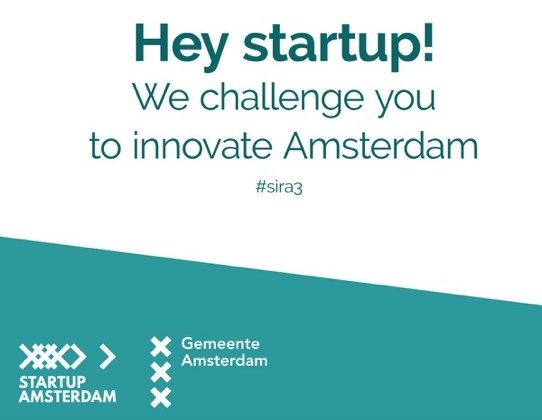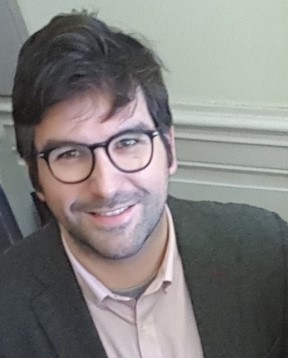Can startups solve urban sustainability challenges?

By Luís Carvalho, School of Economics and Management & Centre of Studies in Geography and Spatial Planning, University of Porto, Portugal
Engaging startups in urban sustainability challenges is becoming a popular policy ambition in many cities worldwide. Yet little is known about whether and how does it deliver. Can startups contribute to systemic urban change while growing their business? How can city-level innovation programmes be designed? In this article, Luís Carvalho examines these issues based on the case of the Startup in Residence programme in Amsterdam.
A new generation of mission-oriented innovation
Perhaps like never before in recent history, the coronavirus pandemic has raised attention to several societal challenges the world has been facing for some time now. Examples are the impacts of climate change on natural ecosystems and public health, the digital transition and persistent social inequalities. Governments are being increasingly called into action, not only to mitigate short-term impacts, but also to pave the way towards a more sustainable future. And now, as in the past, dealing with these challenges calls for systemic innovation, combining technological and social aspects, as well as the involvement of several actors across multiple geographical scales.
To be sure, steering innovation around societal challenges is not particularly new. The famous “Apollo program” – whose technologies landed the man on the moon – is the quintessential example; however, it is fair to say that “mission-oriented” innovation policy has been seeing a recent revival (Kattel and Mazzucato, 2018). Whilst the aim is to solve concrete challenges, for which solution(s) may not yet exist, mission-oriented policy must simultaneously procure innovation, support prototyping and carry out implementation in real-life settings, thus covering the entire innovation cycle from research to commercialization. Up until recently, this sort of policy had been primarily in the hands of national governments, which in articulation with large agencies – with substantial budgets and skills – procured innovation to scientific and technological elites. Sub-national governments were seen as having much less (if any) leeway, namely due to their scope of action and overall lack of formal and technical competence (Uyarra et al., 2017).
However, there are signs that this has been changing. Over the last years, a growing number of local governments worldwide have launched innovation procurement initiatives around concrete “missions” or urban challenges: e.g. how to reduce air pollution, manage mobility, separate waste streams, or facilitate the access to health care. To do so, local procurement budgets became open to new sorts of actors – notably startup companies – with the aim to find and nurture new solutions while at the same time supporting entrepreneurship and new procurement behaviour. Cities like Barcelona, San Francisco or Amsterdam pioneered this approach, but many others are following suit.
Naturally, these policies and programmes are far from straightforward and raise many questions. Can they deliver, and under which conditions? Can they tackle urban sustainability challenges and spur entrepreneurship at the same time? How do the emerging innovations lead to systemic urban change? The remainder of this article sheds light on some of these issues, based on first-hand evidence from the Startup-in-Residence (SIRA) Programme in Amsterdam.
Startup-in-residence in a nutshell: how (and why) does it work?
With the previous ambitions in mind, the City of Amsterdam launched the Startup-in-Residence (SIRA) programme in 2015, under the auspices of its Chief Technology Officer (CTO). SIRA was legally designed as a European-level Public Procurement of Innovation procedure, in which the Municipality opened a formal tender to buy innovation for a bundle of urban challenges, targeting startups as providers. In a nutshell, the programme works as follows:
- The CTO/SIRA team invites municipal departments and associated agencies to formulate urban challenges of their concern, to which off-the-shelf solutions do not exist or are not clearly identifiable (see Figure 1, from the 2019 Edition);
- Startups openly apply and, based on their specific competences, put forward an idea on how to tackle the different challenges. After a selection process, the most promising approach for each challenge is selected, and the proponent startup is invited to enter into a 6-month “in-residence” period to fine-tune and prototype the idea;
- During the “in-residence” period, each startup closely engages with its “client” (the department/agency who raised the challenge), as well as with an external “mentor”, assigned by the SIRA team from a pool of experts (tasked, among others, with helping the startup finding a viable business proposition). During this period, the proposed innovation should be honed further between the parties, prototyped and validated in a concrete, real-life experiment.
- After the in-residence period, results are evaluated and a decision is made on whether the solution devised will (or will not) be bought or licensed by Municipality; under SIRA, a decision to contract out may be taken after a number of years, with no need for a new formal procedure.
Figure 1. SIRA challenges (Sustainability Edition 2019). Source: Startup in Residence Amsterdam (Used with permission).

Since 2015 and over the course of five editions, a total of 51 challenges have been formalized, with 340 startups applying to the programme and 34 selected to go through the in-residence period. By the end of 2019, 16 final procurement contracts had been awarded, and other forms of informal cooperation between municipal clients and startups had emerged (Collette, 2019). Typical innovations resulting from SIRA use technology to nudge social and behavioural change, including: software and digital systems for managing mobility in the city´s famous canals; apps using gamification (e.g. for citizen involvement, or to manage visitor flows); community-based platforms to encourage different sorts of sustainable behaviour (e.g. waste separation; healthy habits); new plastic recycling concepts; devices to connect health providers with the ones in need; on-site sanitation and circular economy concepts; physical systems to prevent plastic flows to reach the oceans, among many others.
Even without further questioning, achieving those is no small thing, and other cities trying similar fell short of these outcomes. So, why does SIRA seems to work?
Amsterdam certainly benefits from many assets that influence the odds of success, such as skilled civic officers, vibrant entrepreneurial ecosystems, a culture of experimentation and a strong sustainability agenda. Yet programme-specific features played a big role too – namely to the extent to which they allowed to productively intermediate between the involved parties, creating “spaces” and opportunities for deeper engagement and the discovery of new solutions. As explored in a previous work (van Winden and Carvalho, 2019), this can be seen along three major dimensions: facilitation, brokering and configuration.
First and foremost, SIRA facilitated the interaction and created a playing field in which the involved parties could more effectively co-create solutions. Participation per se facilitated the access of startups to different sorts of people (inside and outside the municipality) that were often important for the solution´s prototyping and implementation. Moreover, contrarily to other fast-paced startup acceleration schemes, SIRA is considered by many as a more friendly space to innovate, devoid of a “pressure-cooking” feeling – in which the Municipality takes no equity but, instead, facilities seed money for experimenting and prototyping. Additionally the programme is designed to bridge the (often wide) cognitive distance between startups and their municipal clients. To this effect, the in-residence period also involves a training programme during which both civil officers and startups learn about each other´s “worlds”. The same way is used to seduce startups to participate in the programme, a reason why the CTO/SIRA team communicates in a way that directly speaks to startups, instead of advertising through a bureaucratic tendering procedure (Figure 2).
Figure 2. Facilitating engagement. Startup in Residence Amsterdam (Used with permission).

To be sure, even with active facilitation, relations between the different parties (startups, clients and mentors) are not devoid of conflict, and perhaps they should not be. In fact, it has been recently recognised by the programme that a certain degree of friction and disagreement proved important for many of the innovations (Collette, 2019). Yet, at the same time, when tensions emerged, the CTO/SIRA team often played important roles solving them and keeping productive conversations afloat. This brokering role has been relevant not only to deal with on-going issues, but also to encourage startups and municipal departments to engage with the programme in the first place. In this way, beyond facilitating and brokering, SIRA also plays an important role by actually configuring and influencing the directions taken by the innovations – e.g. by helping to narrow down broad municipal challenges and startup ideas, and by helping to strike different sorts of balance between municipal visions and startup ambitions. In this sense, SIRA is not a completely neutral actor or experimentation space but, as with other mission-oriented programmes, it influences the actual direction of innovation.
New solutions or new values?
Beyond understanding how and why such a programme generates and steers innovation, it is also important to think about how it actually contributes to systemic urban change, and whether it can spur entrepreneurship at the same time. In this research, three ways through which these dynamics materialize have been (preliminarily) identified: one that sees innovation as solutions or instruments to solve concrete problems; and two others that see innovation as a news ways to frame problems and understand sustainability (e.g. Kebir et al., 2017; Jeannerat and Crevoisier, 2016). What does that mean?
Some innovations developed under SIRA contribute to solve well-identified urban challenges, e.g. how to monitor and improve navigation in the city canals, or, how to link social workers, volunteers and residents for better assistance and health care. Solutions for those challenges (e.g. a data-rich control system, or a new platform-based software) may become implemented in Amsterdam and beyond, ameliorating urban sustainability problems (e.g. congestion; social isolation) while giving rise to relevant business opportunities for the startup. In this sense, SIRA is an arena in which innovations are tested, experimented and fine-tuned towards a solution that equally benefits both city and startup. Certainly, not all innovations unfold in such a straightforward and balanced manner. In some cases, concepts tend to become too locally-oriented, making it hard for the company to grow a scalable business out of that; and, in others, the (high or low) ambitions of the startup collides with the city interests, or in others, the timing is not quite right. Yet from this angle, the contribution of SIRA to urban sustainability and entrepreneurship runs, respectively, through the effectiveness of the solution and its more-or-less immediate business potential.
From yet another angle, the impact of SIRA towards systemic urban change can also be seen through its longer-term contribution towards increasingly innovation savvy and sustainability-concern municipal “clients”. In this sense, as recently assessed by the programme, SIRA has been contributing to change the perception and awareness of civil officers in relation to certain urban challenges, namely as they go through processes of co-creation with startups with rather different rhythms and worldviews. Hence an additional effect is to enhance the ability to ask different types of questions, keeping a mindset open to out-of-the-box solutions. Ultimately, the programme may contribute to gradually embed new procurement routines in the city administration, in a way that a dependence on well-established suppliers and less sustainable acquisitions is reduced. In this way, the contribution of SIRA towards urban sustainability runs through the accumulation of lessons (of innovation successes, frictions and failures), and the gradual embedding of new routines and sustainability values in the city administration, namely as discussion and expose to new concepts increases (Figure 3).
Figure 3. Networking and dissemination (closing event of the 2019 Edition). Source: Author.

Finally, beyond “solutions for challenges”, one can also see the co-creation process of SIRA as an arena in which new propositions gain wider legitimacy as “sustainable” (e.g. a new concept of on-site sanitation, or a new reward system encouraging more exercising). Because of this, a large number of startups value the media exposure they get, with the SIRA “stamp” being as (or eventually more) important for their business than a contract with the Municipality. While some startups focus on providing relatively straightforward tweaks, others assume they have a broader “mission” to change the world, sometimes with controversial concepts (e.g. recycling urine, or using cryptocurrency to reward sustainable behaviour). In this sense, from the perspective of the city, one outcome of SIRA is to raise new perspectives about what sustainability actually means, and how it can be achieved through sometimes very different types of solutions. Yet this means that if an innovation (and the related business model) is to grow and to be deployed beyond its original urban context, it is very likely that the sustainability values it conveys must travel as well.
Cities, startups and sustainability missions
Beyond solving urban sustainability issues by devising new solutions, the involvement of startups contribute to re-think urban sustainability issues and frame them in new ways. This has become possible as SIRA was designed as a space for intense collaboration, where different perspectives, ideas and values are brought together, seeking synergies but assuming that tension may be productive as well. To be sure, many pressing urban sustainability challenges cannot be solved or transformed by startups alone, and other sorts of larger coalitions are needed, yet the case of SIRA suggests that the energy of cities and startups must be also taken into consideration in contemporary, wider sustainability-oriented missions.
Funding sources
This research is funded by the Regional Studies Association under a FeRSA grant. The support of the Amsterdam University of Applied Sciences (Centre for Applied Research on Economics & Management) and the Startup in Residence Programme is also acknowledged.
References
Collette, S. (2019). Startup in Residence Impact Report. City of Amsterdam, Amsterdam.
Jeannerat, H., & Crevoisier, O. (2016). From ‘territorial innovation models’ to ‘territorial knowledge dynamics’: On the learning value of a new concept in regional studies. Regional Studies, 50(2), 185-188.
Kattel, R., & Mazzucato, M. (2018). Mission-oriented innovation policy and dynamic capabilities in the public sector. Industrial and Corporate Change, 27(5), 787-801
Kebir, L., Crevoisier, O., Costa, P., & Peyrache-Gadeau, V. (Eds.). (2017). Sustainable innovation and regional development: rethinking innovative Milieus. Edward Elgar Publishing, Cheltenham.
Uyarra, E., Flanagan, K., Magro, E., & Zabala-Iturriagagoitia, J. M. (2017). Anchoring the innovation impacts of public procurement to place: The role of conversations. Environment and Planning C: Politics and Space, 35(5), 828-848.
van Winden, W., & Carvalho, L. (2019). Intermediation in public procurement of innovation: How Amsterdam’s startup-in-residence programme connects startups to urban challenges. Research Policy, 48(9), 103789.
About the author

Dr. Luís Carvalho is Assistant Professor at the School of Economics and Management at the University of Porto. He is also Senior Researcher at the Centre of Studies in Geography and Spatial Planning and Scientific Director of the MSc in Innovation Economics and Management. His research centres on the geography of innovation in relation to urban and regional economic development affairs.